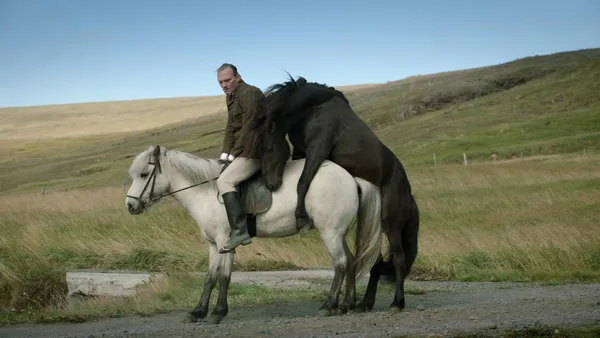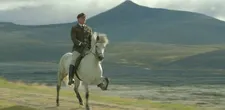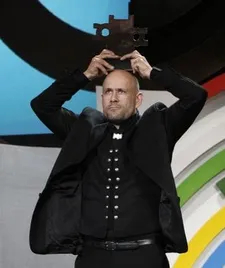 |
| Of Horses And Men won the Tridens and FIPRESCI prizes at Tallinn's Black Nights Film Festival |
The film takes its lead in terms from structure from that oldest of Icelandic art forms - the sagas. And Erlingsson, whose feature-length debut comes after a long and very successful career in theatre, is happy to acknowledge the connection.
"I've done two performances in which I've told the sagas," he said, speaking from the theatre as he prepared for his latest production of Aristophanes' Congresswomen. "A lot of the elements of the story are based on this. You can say the Icelandic sagas are like episodes that intertwine. In essence, it comes down to oral culture, because the sagas come from the oral culture of telling stories.
 |
| Ingvar Eggert Sigurðsson in Of Horses And Men. 'The stories of this film are like stories that have the oral culture aura around them.' |
The film reflects on the life of the islanders from the perspective of the horses that they live alongside. Each segment begins with someone mirrored in the eye of one of the animals and almost all feature a mixture of comedy and tragedy - from an alcoholic so desperate he rides a horse out to sea to a randy stallion with an insatiable appetite and a couple whose lust almost outruns their horses'.
Erlingsson is a keen horseman and has owned the animals since he was 13 years old.
"I had a horse that was born in 82," he says. "She was 33 years old and I had to put her down just a week ago. She was my companion. In fact, I have a daughter with the same name, I named my daughter after her and she, the horse, is also named after my grandmother so this issue that a horse can be a part of a family or a character is a reality in my life."
It wasn't just the director who was good rider, it was also a prerequisite for his crew and, particularly, his cast, many of whom have to ride the horses as part of their tales.
He added: "In Iceland, it happens that horsemanship is a very common sport among actors.You don't have to be an aristocrat to have a lot of horses in Iceland - it's a common man's sport. So there are a lot of actors who have horses. When I talk to my European friends and tell them I have five horses, they think I am a very rich man but it's a cultural difference. I did not want to fake that element, that the actor was a good horseman."
Because of this, Erlingsson says that capturing the animals on camera "turned out to be rather easy".
Bergsteinn Björgúlfsson, my cinematographer and I are both trained horseman and tame horses so we both have some knowledge of how you whisper to a horse, as you say, talk to the horse. But the first day there was much more trouble working with the tractor than with the horses. I was criticised in the shooting period because I was always congratulating the horses for a good performance but didn't say anything to the actors.
"Of course, this is something you have to be prepared for. I had a lot of professional horsemen and had divided the work between them. This is my first film and none of them had worked in show business like this, we were just working with our horses - none of them were specially changed, its just characters."
Erlingsson's film captures the essence of these characters and is full of striking images, such as a stallion driven so wild with lust that it mounts a mare without waiting for the rider to get off and or the scene where the alcoholic takes his horse into the ocean. He says these tales are based on anecdotes, including the tale of a man who swam out to a French schooner in order to buy booze.
Saying that the story relates how the man let the horse tread water while he boarded the ship, Erlingsson adds: "That was the most brutal thing. He just tied a horse with a rope and he climbed up with a rope while the horse was swimming all the time while he was buying some cognac."
And he says that the horses - who are often very good swimmers - had no problem taking to the water.
 |
| "It's not so hard for the horse as you think it is." |
As for that stallion sex scene - which he describes as "the sandwich" - initial fears that the male horse might bite the rider were ill-founded.
He adds: "It turned out easy but we worried about it a lot. The essence is that the mare had to be ready and there are one or two days in her cycle when she gives off the hormones that makes the stallion crazy. And when she is ready, nothing will stop her and nothing can stop the stallion. If you have the right stallion that's not very tame and is a little bit without respect for humans. So it was all about the timing. To be with the right mare at the right time."
In terms of timing, the shoot did prove slightly tricky thanks to the number of Hollywood films that were being made in his homeland at the same time - it's clear that though they presented a few logistical problems they also gave the islanders a lot of laughs, whether they intended to or not.
"Tom Cruise was also doing Oblivion and Ben Stiller and Aronofsky were also there. Russell Crowe was working there with Aronofsky," said Erlingsson. "So they had hoovered up the most professional crews in Iceland, so we were working with the rest. A lot of us were beginners and it was hell in some sense but, in the end, they turned out to be the best. We learned a lot. We tried to have as many people in the crew that were horsemen also.
 |
| Benedikt Erlingsson with his Kutxa-New Directors award at San Sebastian Film Festival. Photo: Montse Castillo/©Festival de San Sebastián |
With a slew of awards under its belt and the honour of being Iceland's nominated film for the Oscars - although it didn't make the shortlist - this may be Erlingsson's first feature but it's unlikely to be the last. The director says that film gives him more freedom in his writing than his theatrical work, which he generates "not by sitting on my arse but by standing on my feet and miming and performing and so on".
He added: But when I write a film manuscript, I feel freedom, because it's not literature that I am creating so my magical child is totally free in that sense, I feel I can play with that medium."
And he is certainly planning more.
"I joke to my wife - Charlotte Boving, the main actress, is my wife - that the theatre is my wife and film is my lover and I'm trying to divorce my wife and take a steady relationship up with my lover. So that's the aim. But, of course, there are a lot of great filmmakers that come from theatre and film is a very young art. We have an Icelandic film fund that has been cut down and there is a lot of havoc in Icelandic social and economical life so this will continue to be a fight. But I hope that this film will help you to make the next one.
"I want to make more 'silent' films like this. As a filmmaker from Iceland - and island of 300,000 people - I need a bigger audience, I think, just to survive as a filmmaker."
"This theme of human being as an animal has followed me for a long time," he said "When you work with a play like this [Aristophanes' The Congresswomen] that is so old, you see the same animal working with the same social problems - the same injustice, the same corruption - they have not changed. It's like old faces. I made a short film once, called The Nail and it was about a man who got a nail in his head and changed into some kind of animal. It has been a theme, that is, of course, international."
International festival programmers appear to agree as the film continues to globe-trot - next appearing at Palm Springs International Film Festival in January - where it will compete in the Awards Buzz and New Voices, New Visions sections - It's also going to be screened at the Scandinavian Film Festival in LA which runs from January 18 to 26. Let's hope it gets a UK distributor soon.
Editor's note: Our wish has been granted and the film will now be released by Axiom in the UK on June 13. We also caught up with Erlingsson again when his film showed at New Directors/New Films in New York, read what he told us about his next project






















